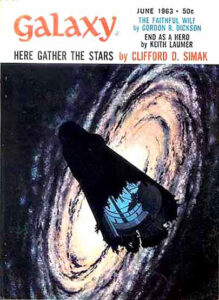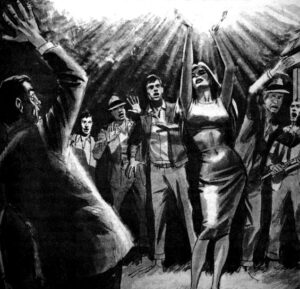 It’s funny how my reading choices are more a train of thought than anything else.
It’s funny how my reading choices are more a train of thought than anything else.
Take Clifford D. Simak. I mentioned him last week.
As I was finishing up Red Harvest, I turned to my fallback when I started looking for something to read next: science fiction.
I wanted something from the pulp era, but really didn’t feel like space opera. And to tell you the truth, while I enjoy space opera for its sheer escapist appeal, I prefer harder sf. It makes you think.
I started looking through my options at hand, but nothing jumped out at me. Then I recalled reading a reference to Simak’s novel, Way Station, a few weeks ago. It was mentioned that it had been optioned for a possible Netflix movie.
While Simak is a pulp-era fictioneer, Way Station was written well after the pulp era. It was originally serialized as “Here Gather the Stars” in Galaxy Science Fiction in June and August 1963. At least Galaxy was one of the sf digest magazines that filled the void left by the pulp magazines as that medium faded out in the 1950s.
Simak got his start in Wonder Stories in the early 1930s, also wrote for the aviation and western pulps for a bit, and continued writing into the 1980s. That’s an extremely quick sketch of the career of a highly acclaimed fictioneer.
I always enjoy when a book turns out to be unlike what I expected when I start reading it. Way Station was one of those books.
I had read at Gizmodo:
The novel centers around an American Civil War veteran named Enoch Wallace, who’s chosen by an alien to monitor a way station on Earth, which is used by intergalactic travelers as they journey across the universe. The job grants him many gifts: Not only does the technology render him immortal, but he also meets countless aliens from across the galaxy and gains immeasurable knowledge from their encounters (although some are not so keen on humanity, given their violent leanings).
Well, that’s not a very accurate description of the novel. (For instance, Enoch isn’t immortal.) Based on that description, I expected a straight-forward narrative telling of Enoch’s century or so running the way station. The story is more involved, which was a pleasant surprise.

It actually takes place in a short period based around the time the novel was published (the early 1960s). But Simak manages to tell Enoch’s and the way station’s histories in parallel with the main action, and they all tie together, of course.
Star Trek fans will notice at least a couple of familiar technologies: a holodeck-like room and teleporters that link the way station to the rest of the galaxy. Though, the teleporters have a bit of a gruesome element to them.
As I finished up Way Station, I started thinking of modern science fiction. Shortly before the movie Arrival came out, I read the short story, “Story of Your Life,” that it was based on, then ended up reading the whole collection, Stories of Your Life and Others, by Ted Chiang.
When Chiang’s newest collection, Exhalation: Stories, came out earlier this summer, I read it immediately. What really draws me to Chiang is that his stories make me think, and they have a Twilight Zone-like vibe.
After Exhalation, I looked for something similar. There was a recommendation for Greg Egan, so I started reading his collection, Axiomatic, this summer. While good, Egan’s stories just didn’t compare to Chiang’s, at least in my opinion. I was rarely surprised by how the stories turned out.
So after Way Station, the Chiang train-of-thought led me to The Three-Body Problem, the 2015 Hugo-winning novel by Chinese author Liu Cixin. It’s the first of a trilogy, but I’m uncertain if I’ll continue on to sequels yet.
Okay, I’ve gotten off the subject of pulps. Well, sort of. We’ll get back on topic next time.




Your comments